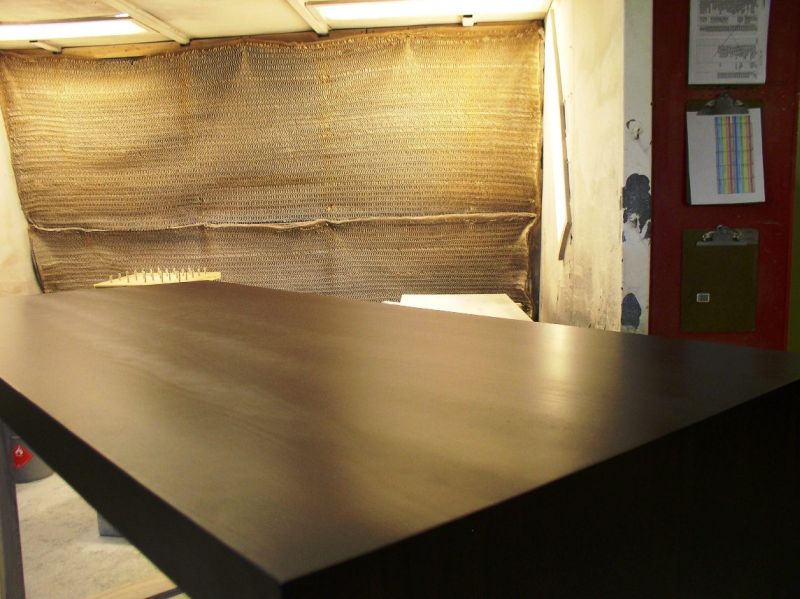CAB Acrylic Peeling Problem
Acrylics made with cellulose acetate butyrate (CAB) can have durability issues in damp or chemically challenging environments. June 8, 2008
Question
We built and installed a maple kitchen with Sherwin Williams cab/acrylic lacquer about 5 years ago and now the lacquer is lifting off, mostly around the edges and corners. The job is in a dry environment and the kitchen isn't damp or moist. Does anyone know a good solution without having to completely strip the entire kitchen?
Forum Responses
(Finishing Forum)
From contributor J:
The problem with maple is that when it is machined, especially around tight corners and curves and sometimes even on flat surfaces, it tends to glaze over. If it isn't sanded well enough, the finish doesn't adhere to the wood and it becomes only a matter of time before this happens. Fix it by sanding it down really well and respraying.
From the original questioner:
The doors are shaker and are square. The finish is also peeling along the floor at the bottom of the kicks from maybe mopping. I think the painter didn't use sealer - that was one of his tricks to save time, although it's hard to prove 5 years later.
From contributor C:
Is this a stain and clear job or a paint or paint and glaze?
From the original questioner:
It was just a clear finish over maple. Corners and wet areas are the worst. We used Sherwin Williams cab acrylic 550 voc. Maybe a bad batch?
From contributor R:
Please don't take offense at this question, but was this a one coat of sealer and one top coat job? Did the painter use a vinyl sealer under the cab acrylic? If you say that corners and wet areas are the worst, I think you have answered your own question. It's a moisture problem. Are the areas under the peeling lacquer kind of a grey color? If the bottoms of the doors and drawers are peeling as well, you have moisture attacking the finish. I would not consider re-coating over the existing finish with a new finish a cure for the problem. Also, if the edges are too sharp and happen to get nicked or dinged, once the finish has cracked, that opens up a door for the moisture to attack the finish. I don't think you got a bad batch of material, I think somewhere along the line the painter skimped on the quality of the finish or the customer or the customer's maid is constantly cleaning the cabinets whether they need a cleaning or not.
From contributor B:
CAB lacquers are fantastic for yellowing resistance, but are not the best when it comes to moisture resistance and impact resistance. It has been my experience that CAB resin tends to bridge on sharp edges and inside corners (something to do with the nature of the resin molecule I think) when applied by folks who are not familiar with the pratfalls of CAB lacquers. You can "fix" this, but that is all it will be without stripping and reshooting the job with a coating more suitable for the construction of the cabinets and the environment to which they are subject. While you may think the kitchen is in a dry environment, that does not mean that there have not been spills, steam from the dishwasher, coffee pot, and other sources of moisture. I completely agree with contributor R's assessment about moisture. Reduce or eliminate the source of the moisture before making any other considerations.
From contributor C:
The butyrate component is the main problem. Cellulose acetate and butyrate are two different polymer components usually offered in a dual component form for ease of addition. There was a time when you could easily buy either by themselves as a single component coating. The butyrate by itself was a nightmare waiting to happen.
I personally stopped using CAB acrylics back in the 70's because of problems like you mentioned and only use acrylics of the methyl and ethyl types on woods being subject to high moisture areas. Cellulose acetate I can still stomach, but butyrates are a no no. The questioner told me it was a thick glossy finish when it left the shop, so I don't believe it was only a two coat process, not that this is proof it's not water related.
From contributor T:
CAB/acrylic is a great finish for many applications today and is still used on a lot of fine furniture. It is not a good finish for kitchens, bathrooms, laundry rooms or any other area that is likely to see moisture or caustic cleaners. It has low moisture resistance, low heat resistance, low chemical resistance, and doesn't have great adhesion without a sealer. I'm not an authority on KCMA standards, but I would be amazed if it comes close to meeting them even with vinyl sealer. Best to admit a mistake, strip and recoat with a KCMA compliant finish.
From contributor C:
I can't speak for all CABS available, but yes, it is endorsed by KCMA when used with a vinyl sealer. There are non-CAB acrylics like the ones I use that are every bit as good as pre-cat lacquer. They have no CAB component in them. These have been used in Florida for a couple decades now in kitchens, bathrooms, etc., without any problems. Homes running in the 20, 30, 40 million dollar range, it depends on the chemistry more than anything else. Don't throw the baby out with the bathwater, just switch to a non CAB acrylic able to withstand the environments intended for its use.
